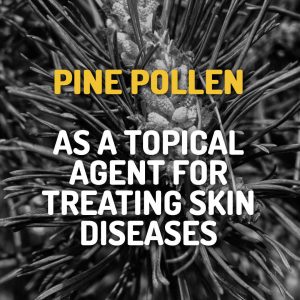As nature unveils its countless medicinal wonders, there is one golden secret that often goes unnoticed – pine pollen.
Despite its humble appearance, this yellow dust holds a treasure trove of nutrition and health benefits waiting to be discovered.
Pine pollen is the male spore of Pinus massoniana Lamb., Pinus tabuliformis Carr., and other plants of the same genus.
With a long traditional history of edible and medicinal usage in traditional Chinese medicine (TCM) for boosting the immune system, increasing energy, as an aphrodisiac and for its purported anti-aging properties.
Join us as we delve deeper into the world of pine pollen.
1. Pine Pollen – The “Natural Micronutrient Storeroom”

Often referred to as a “natural micronutrient storeroom” in the scientific literature, pine pollen contains over 200 nutrition elements.
Some of these include 22 body-demanding amino acids, 15 vitamins, 30 minerals, 100 enzymes, nucleic acids, unsaturated fatty acids, lecithin, flavonoids, monosaccharides and polysaccharides.
Pine Pollen rightly deserves its reputation as a “superfood, due to its impressive nutritional profile.
2. Balance Hormones – A Source Of Phyto-Androgens

Research has found that Pine Pollen contains a small source of “phyto-androgens”.
“Testosterone, epi-testosterone and androstenedione were found in the pollen of Scotch pine P. silvestrisL. (Saden-Krehulaet al., 1971)” – [2]
Pine pollen contains all four major androgen (male sex) hormones, androstenedione, testosterone, dehydroepiandrosterone (DHEA), and androsterone (Danuše, 2019). – [3]
By working to regulate hormones naturally, pine pollen may bring relief from symptoms associated with hormonal imbalances such as low testosterone, whilst increasing sex drive, fertility, energy, mood and improving overall vitality.
3. Pine Pollen As A Topical Agent For Treating Skin Diseases

You wouldn’t think this magical golden dust could be used as a topical agent in the treatment of skin diseases.
However, a Bibliometric Analysis of Pharmacological and Clinical Studies on the potential effects and use of Chinese Herbal Medicine Pine Pollen (Pinus pollen) published 2020 concluded:
Its use as a topical agent, especially for skin diseases, was notable.
More than half of clinical studies have reported that pine pollen was used as a topical agent for skin diseases, suggesting that pine pollen may have great potential in the treatment of skin diseases. – [1]
The study found that some of the most frequent clinical diseases treated or where pine pollen was used as an adjuvant were skin disorders such as bedsores, eczema, diaper dermatitis, oral mucositis and radiodermatitis.
4. Pine Pollen – A Wide Range Of Health Benefits

A review published 2023 summarized the published findings relating to the chemical compositions, health effects, processing and storage, and food applications of pine pollen.
The review concluded that Pine Pollen has multiple potential therapeutic applications and health benefits.
Pine pollen is a rich source of macronutrients and bioactive compounds that have demonstrated various health benefits, including antioxidant, immunomodulatory, anti-inflammatory, glucose and lipid metabolism regulatory, antimicrobial and antiviral, antitumor and anticancer, hepatoprotective, gastrointestinal modulatory, anti-aging, and other biological properties. – [4]
Recommended Product:
Na’vi Organics Pine pollen is harvested by hand from pine trees (Pinus Massoniana Lamb) in the mountainous wilderness of the northwestern part of the Yunnan province bordering Tibet.
Their Pine Pollen powder is broken cell, and is processed through a very low temperature and high speed airflow sporoderm-breaking technology, leaving 99% of the pine pollen with the cell walls broken.
Na’vi Organics supplements are some of the highest quality on the market in my opinion.
From a non-irradiated source and absolutely free of any additives and fillers, synthetic ingredients, preservatives, flours and other bulking agents, GMO’s, dairy and gluten.
Tested and certified pure from contamination of heavy metals, molds, chemicals and bacteria.
SHOP LINK: Wild Harvested Pine Pollen – Broken Cell Wall Micro Powder
References
[2] Testosterone, epitestosterone and androstenedione in the pollen of Scotch pine P. silvestris L
[4] Pine pollen: A review of its chemical composition, health effects, processing, and food applications
The information in this article has not been evaluated by the FDA and should not be used to diagnose, cure or treat any disease, implied or otherwise.
Always consult with a qualified healthcare professional before making any significant dietary or lifestyle changes including supplements and herbs.




